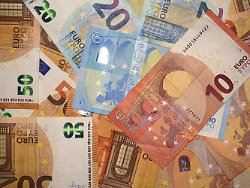Monday, December 6th, 2021
The population is allowed to have a say
Euro bills get a new design
When the euro was introduced in 2002, the banknotes were kept neutral. For the time being there is no room for national sensitivities. That could change with the new design. The population should later have a say in what can be seen on the banknotes.
Is the euro getting more emotional? “We want to develop euro banknotes with which the citizens of Europe can identify and which they use with pride,” announced ECB board member Fabio Panetta. In a multi-stage process, the monetary authorities want to fine-tune the design of a new generation of the common currency. The central bank wants to involve citizens comprehensively, in 2024 the ECB Council should then decide on the production of new notes and also on when they can be brought to the people.
“After 20 years, it is time to take a close look at the design of our banknotes and design them in such a way that Europeans, regardless of age or background, can better identify with them,” said ECB President Christine Lagarde. The central bank is also signaling that there will still be cash – even if electronic means of payment are on the rise. For 11 of the then 15 member states of the European Union, the euro became legal tender on January 1, 1999 – initially only electronically, from January 1, 2002 on in the form of notes and coins. Today the euro is the official currency for around 340 million people in 19 EU countries.
The security features of the notes as protection against forgery have been revised and expanded in recent years. The second generation of euro banknotes was completed in 2019. The first-generation euro notes are still valid and are gradually being withdrawn from circulation by the central banks. The – comparatively sober – motifs on the notes have been preserved: buildings that do not actually exist. Quite different in the D-Mark era: Bettina von Arnim, Carl Friedrich Gauß, Annette von Droste-Hülshoff, Clara Schumann, the Brothers Grimm – famous personalities, well-known buildings and objects instead of fantasy architecture adorned the banknotes back then.
When designing the euro bills in the 1990s, there was little room for national sensitivities, as the then ECB chief economist Otmar Issing describes: “When we discussed at the Bundesbank what the new euro bills should look like, I was from the start aware that this is only possible with symbols that have no national character, “recalls Issing. “Imagine if the French insisted on having Napoleon on a banknote. The countries that suffered under Napoleon would have protested. And so there are many examples. They then opted for symbols of a completely neutral nature: Bridges. That should be the symbol: The euro builds bridges in Europe. ”
When designing new banknotes, Europe’s monetary authorities now want to build bridges to consumers. The ECB will “work with European citizens in a process that should lead to a final decision in 2024,” announced the central bank in Frankfurt. As a first step, focus groups will be set up to collect opinions from people across the euro area on possible topics for the future euro banknotes. A thematic advisory group, in which an expert from each euro area country is represented, will then propose a selection of new topics to the Governing Council. The ECB will then ask the public for their opinion on the selected issues. After the drafting process has been completed, the Governing Council will decide on the production of the new notes and their possible issuing dates.
Candidates for membership may have a say
The people in Bulgaria and Croatia should also be involved in the process. Both countries have been trying for years to meet the criteria for admission to the Euro Club. On January 1, 2015, Lithuania was the last country to join the group of countries with the common currency as the 19th member.
According to the ECB, it is completely open what a possible new generation of euro banknotes will look like. Nothing is ruled out, one is curious to see what ideas will come from the population. Ultimately, the Governing Council, as the highest decision-making body of the central bank, also decides whether the current denominations will remain (5, 10, 20, 50, 100 and 200 euros) and whether future notes will be equipped with additional security features .
One thing is certain: it will take some time before people have to get used to renewed euro banknotes. Even in the event of an ECB decision in 2024, revised banknotes would not be released to the people until years later after extensive tests. Such a project is a logistical challenge anyway: in October 2021, according to the ECB, more than 27.6 billion euro banknotes with a total value of over 1.5 trillion euros were in circulation.
